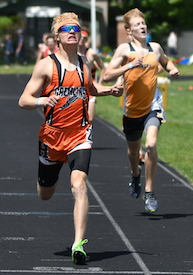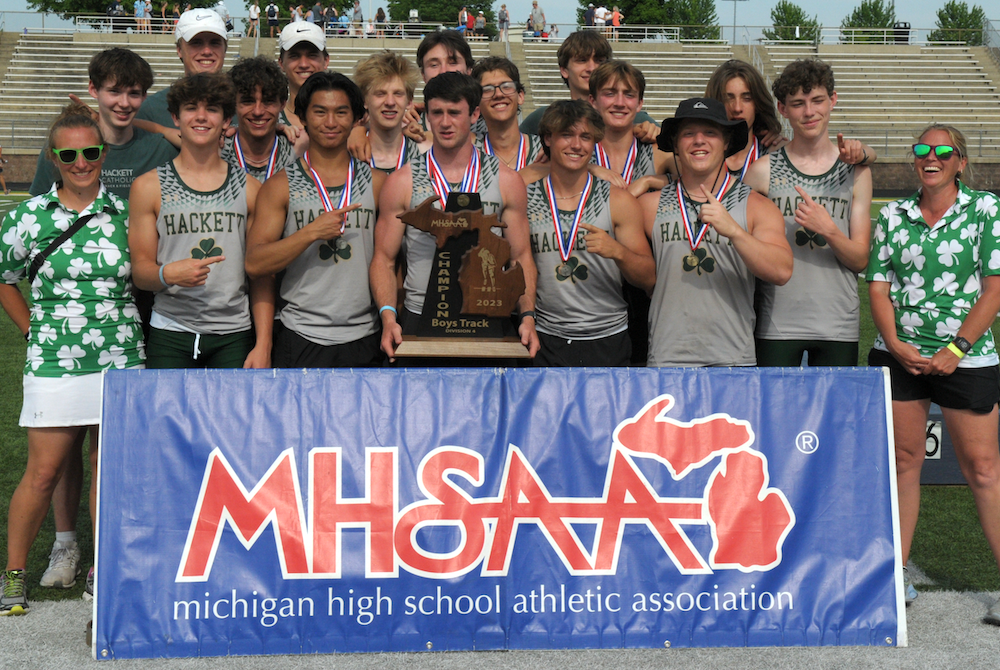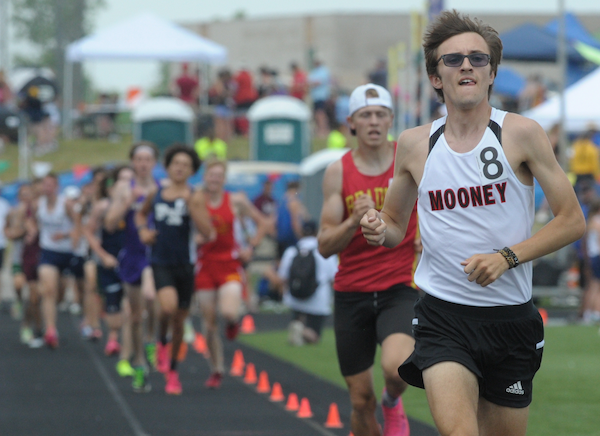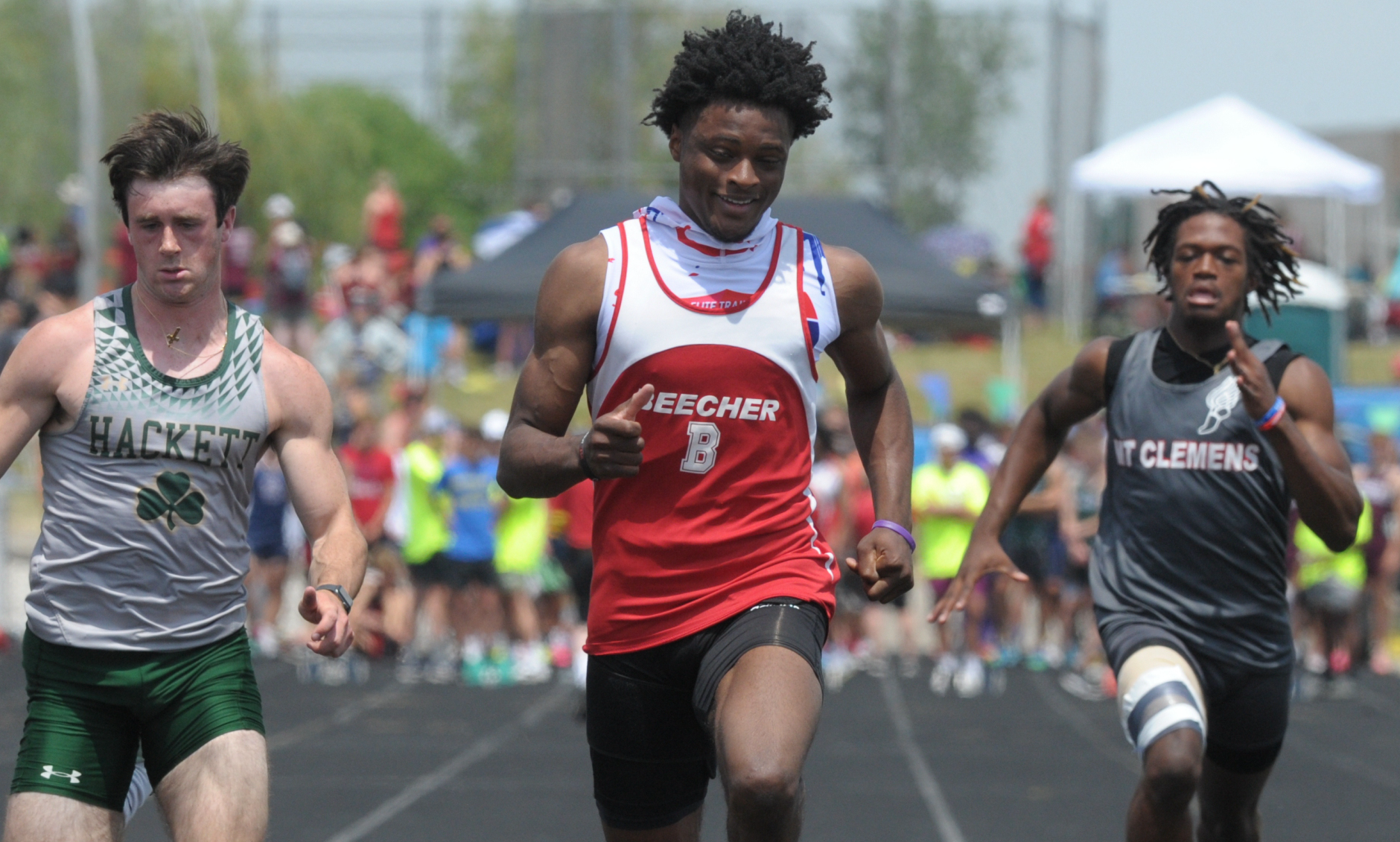
Marquette Rises to Match Challengers
By
John Vrancic
Special for MHSAA.com
June 2, 2018
KINGSFORD — The Marquette boys continued their hold on the Upper Peninsula Division 1 track title Saturday, winning for the fourth straight season with 110 points.
Houghton edged Gladstone 86-76 for runner-up honors.
“Competition in D-1 was the tightest I’ve seen in a long time,” said Marquette coach Kyle Detmers. “It was very competitive. It was a battle until the 3,200 when it was just a seven-point difference between us and Houghton.
“It was just packed. I haven’t been in a D-1 Track Finals that was this competitive to the end.”
Senior Garrett Rudden helped the Redmen gain some separation by placing third in the 3,200-meter run in 10 minutes, 14.41 seconds and helping the winning 1,600 relay (3:35.87). Teammate Garrett Zueger took fourth in the 3,200 (10:28.68) and helped the Redmen take the 3,200 relay (8:30.74).
The Redmen had a double winner in junior Raphael Millado, who captured high jump (6-2) and long jump (19-6).
“Raphael has jumped as high as 6-6 and more than 21 feet (in long jump),” said Detmers. “The wind swirling around down there may have affected the jumping events. We also had a guy (Ethan Martysz) pull up with a hamstring injury in the 100 and pull out of the 200, but the guys fought through it. Drew Thomas taking second in the 110 hurdles and Garrett’s second in the 1,600 were huge for us, and Matt (Pillifant) was seeded seventh and placed fourth in pole vault. We stayed steady and scored in all the field events. I’m thankful for the guys’ resilience and ability to pick each other up. Every point mattered.”
Houghton senior Clayton Sayen won four individual events, taking the 100 (11.47), 200 (23.19), 400 (51.25) and 800 (1:59.31), in the last edging Negaunee senior Colton Yesney (2:00.24).
“It was fun,” said Sayen, who plans to continue his track career at Michigan Tech. “I rely on my speed for everything. I’m thankful for our coaches who always knew that was best for me. Without their guidance, I wouldn’t have been able to achieve what I did. I also want to make a special shout-out to Seth Helman. Running against him in the 800 was a bittersweet moment. He’s my closest friend; I’m really going to miss the time we had together. I’m thankful for the competition we had.”
 Houghton coach Dan Juntilla said he was pleased with the team’s effort.
Houghton coach Dan Juntilla said he was pleased with the team’s effort.
“Our guys gave it their all, but Marquette was a little too deep for us,” he added. “I’m real proud of the guys. Seth and Clayton had a great day, and placing second in the 3,200 relay set the tone. Plus, taking three places in pole vault gave us some big points.
“We’re looking forward to having our new facility next year and really excited about what the taxpayers of Houghton did for us.”
Yesney, who plans to continue his running career at the University of Michigan, won the 1,600 in a school-record 4:23.49 and 3,200 (9:54.43), missing the U.P. meet record by four tenths of a second.
“I’m a little bummed out,” he said. “I thought I had the record. I could envision myself getting the school record in the 1,600. Usually, when that happens it works out well. I thought I had (Sayen) in the 800, but he has that sprinter’s speed and just enough endurance to get it done.
“I’m really looking forward to going to U-M, running for one of the best programs in the nation and running against some of the best runners in the nation.”
Gladstone’s leader was freshman Calvin Thibault, who won the 110 hurdles (16.12) and 300s in a school-record 40.04 seconds.
“I knew what was at stake with us being so close to Marquette (before the 300s),” said Thibault, who’s battling an asthmatic condition. “My family and girlfriend (junior Hannah Christe) were here, and I thought about them during the race. Hannah makes sure I get enough rest and energy to run. At the beginning of the season, I didn’t think I’d be able to do this well, especially in the 300 hurdles. I didn’t know what to expect.”
PHOTOS: (Top) Marquette’s Raphael Millado clears the bar on one of his high jumps. (Middle) Houghton’s Clayton Sayen, left, outkicks Negaunee’s Colton Yesney to win the 800. (Photos by Cara Kamps. Click for more at RunMichigan.com.)

Thrower Claims Lone Individual Title to Lead Hackett to Team 3-Peat
By
Tom Lang
Special for MHSAA.com
June 3, 2023
Kalamazoo Hackett Catholic Prep just keeps winning and winning.
This time the Irish took home their fourth title in the last five Lower Peninsula Division 4 Track & Field Finals, on Saturday at Hudsonville.
Hackett’s only individual title was taken by discus winner Nathan Buchmann, a senior, who was fine knowing he was the shortest in stature among all the sizable competitors.
“In the offseason after football I worked out every day, working towards this goal,” he said after getting his medal. “I would say this takes 80 percent technique and 20 percent strength to throw the discus. So, length can help but if you have good technique and are really strong, that will play into it.
“I think we are very balanced throughout the meet today,” he said about teammates that scored points in finishes other than first place. “We have 13 guys here today, and we have people in a lot of the races. But I do not run; I have too short of legs to be a fast runner,” he said with a chuckle.
Buchmann had to work through a hip injury to compete this spring.
“I think the setbacks are what make you strong,” he said. “You can either give up through the setbacks or push forward and become better.”
 Coach Charissa Dean agreed.
Coach Charissa Dean agreed.
“The kids have big hearts,” she said after all the points were totaled and the Irish were on top once again, with 53. “They worked hard. They had a lot of potential when we started the season. And we had a lot of drive to put in the work, and we are happy the results came out the way they did.”
Reading was runner-up at 47 points, followed by Wyoming Potter’s House Christian with 42, then Fowler and Flint Beecher each with 37 points.
Senior Lezawe “Moses” Osterink, of Potter’s House Christian, placed second in 1,600 but took the 3,200 title as defending champ of both. He dominated the latter by lapping the field with a final lap kick that resembled more of a superhero speedster.
“Nobody really took it out that hard at the start,” he said. “There was a freshman (Marek Butkiewicz of Hackett) that tried to get the pace going quick, but me and Dakota (Dykhuis of Montabella) just kind of sat back and gradually pulled him through.
“We took it gradually, and I was just relying that I could kick.”
Kick did he ever. The trio were neck and neck the majority of the race in a grouping ahead of the pack.
“With 400 to go I just tried to go all out,” Osterink said. “I had a lot more left than I thought and I was pleased with the win. Not really the time, but that doesn’t matter, especially this hot out.”
The overall meet was in the low 90s/high 80s heat and searing sun all day. So, race officials allowed the unique opportunity for coaches to spray the runners with water and give them water bottles.
“It was very weird because I’ve never taken water to drink while I’m running, so I didn’t know how that would feel,” Osterink said. “And they were spraying us and hitting us in the face. It was kind of fun.”
Junior Tyler Lenn of Marine City Cardinal Mooney defeated Osterink at his own game in the 1,600.
“I’m feeling great,” Lenn said after grabbing the medal. “I said to a newspaper after one of my races (during the season) I was right where I wanted to be. This has been a long rebuilding process for me since an injury back in the fall, and I set a pretty high goal the day the injury happened. I was telling myself I needed to fulfill what I said I would do at the beginning of last cross country season. And that is what I did today.”
Lenn suffered an ankle sprain from a misstep that turned worse because he kept running through the season on it.
“Coming back from that was pretty tough, but I wouldn’t have it any other way,” he said.  “Perseverance; I said from the beginning what I was going to do. I kept my eye on that target, and no matter the circumstances life threw at me, that I was going to make it happen and I am a man of my word.”
“Perseverance; I said from the beginning what I was going to do. I kept my eye on that target, and no matter the circumstances life threw at me, that I was going to make it happen and I am a man of my word.”
Jaylin Townsend, a senior from Flint Beecher, dominated the short races. He won the 100 dash (10.67) and 200 dash at 22 seconds flat. It was his third 100 win at a Finals.
“I put in a lot of work; I had to three-peat,” he said after the 100. “There’s a lot of great competition here, so I knew I had to come out and run my best.”
Concord in the 400 (43.72), Buckley in the 800 (1:30.76) and 1,600 (3:29.13) and Potter’s House in the 3,200 (8:14.18) were relay champs Saturday. Reading’s Tayshawn Bester won the 110 hurdles (15.13), and Athens’ Landen Bennett won the 300 (39.85). Caseville’s Nathan Feltner won the 400 (50.76), and Vestaburg’s Owen Patton claimed the 800 (1:55.11).
Fruitport Calvary Christian’s Bradley Richards won the high jump (6-10), and Peck’s Alex Affer won the long jump (23-4). McBain Northern Michigan Christian’s Isaac Bowden was first in pole vault (13-0), and Brown City’s Kyle Affer won shot put (49-2).
PHOTOS (Top) Kalamazoo Hackett Catholic Prep celebrates its third-straight LPD4 title Saturday. (Middle) Cardinal Mooney's Tyler Lenn, far right, sets the pace in the 1,600. (Below) Flint Beecher's Jaylin Townsend, middle, crosses the finish first for one of his two sprint championships. (Photos by Ken Swart/RunMichigan.com.)

